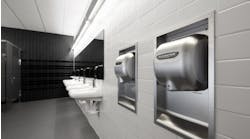“Can you believe the price of fuel these days?” It's an unwelcome conversation that has come into our daily lives. With the national average cost of diesel fuel hovering around $3 per gallon, school and university administrators face the challenge of compensating their budgets for money lost to the gas tank.
Some are playing with numbers, looking at their budgets for ways to move money around and make things work. Others are scouring for places where cost savings might not be realized and changing their day-to-day operations. Whether budget crunching or making changes, education institutions should keep student safety at the forefront of their mission to offset the increased price of fuel.
Routing for cost savings
One of the more obvious solutions to saving on the cost of fuel is to cut down on the amount of fuel used. This can be done by changing routing procedures or by decreasing the need for travel.
At DeSoto County Schools in Hernando, Miss., bus routing is organized for maximum efficiency.
“We try to minimize the students' time on the bus for their sake, as well as minimize the time on the road, which can save us money as well,” says John Caldwell, district transportation director.
The School District of Hillsborough County (Fla.) is taking a step to cut costs by zeroing in on some of the stops it has been making at after-school daycare programs, as well as bus dropoffs within two miles of schools.
The Florida Department of Education reimburses school districts a certain percentage of the cost to transport students from home to school and from school to home, but anything beyond that is considered a courtesy, says Karen Strickland, general manager of transportation.
“We can't do all the things we want to do — that parents want us to do,” says Strickland. “We just can't do it anymore. Our money needs to go back into the classroom, not into gas tanks.”
Although some courtesy stops are being eliminated, the district still will review areas near schools on a yearly basis to ensure that they are safe for pedestrian travel. Courtesy stops would not be eliminated if an area were unsafe for walking.
Zooming out from day-to-day operations can shed light on other ways to save on transportation costs, such as reducing the need for travel.
Some schools have programs for special-needs students, and sometimes students from a large area are bused to one school to participate in the program. In this case, it might be beneficial for a district to assign two programs to reduce travel time, says Strickland.
“It's like a bigger picture; it can't be just one department,” she says. “It has to be the school district that looks at their expectations, as well as their demands — working together to see what would serve the students, as well as serve the district.”
Fleeting assets
Schools and universities also can save money by cutting down on the number of vehicles owned and used by faculty and staff.
In Florida, Hillsborough County saw the trend of high fuel prices developing several years ago and set up a districtwide committee to evaluate every person that took home a county car, says Strickland.
The committee looked at each department and at each individual within that department to determine whether the car was necessary for the individual to do his or her job. This analysis resulted in fewer faculty and staff having district-owned vehicles, which cut costs, she says. Instead, faculty and staff who need to travel for the district use their personal vehicles and are reimbursed for mileage.
The University of North Carolina at Chapel Hill has cut down on the number of cars on campus with its Zipcar program. For about $20 per year, those who don't bring cars to campus can join this program and rent cars for their use. Cars can be reserved online and accessed by waving an ID card in front of the car to unlock the door. Users pay $5 per hour — a maximum of $55 per day — and do not pay for gas, says Claire Kane, transportation demand coordinator.
Fueling up
Sometimes routes can't be consolidated and vehicles can't be eliminated. Service and maintenance vehicles have to stay running because there are always repairs to be made on campus or in a school facility.
“The infrastructure-type vehicles pretty much have a job to do, and they're going to do it,” says Jim Bogan, fleet program officer at the University of Wisconsin — Madison. “It costs what it costs, and we just pay the money.”
But education institutions can achieve savings even when purchasing fuel. The University of Wisconsin — Madison takes advantage of its exemption from federal excise tax on fuel by having bulk fueling facilities and using a fuel credit card.
The university gets a better price on fuel by filling up its 10,000-gallon tanks and buying in bulk, but that's balanced by the cost of maintaining the tank, says Bogan.
“It isn't necessarily cheaper in the long run — it's more convenient,” he says.
Using a fuel credit card can result in big savings. There are some companies that offer fuel credit cards specifically for fleets, Bogan says. These card companies offer tax-exempt programs that work with different point-of-sale merchants.
“If we use our fuel card at one of their point-of-sale merchants, we buy the fuel net of tax right there,” says Bogan. “In general, with fuel, for an institution that is exempt from federal excise tax, if they're not using a tax-exempt fuel card program, they could be saving a lot of effort and money if they were.”
The Hillsborough County school district uses a bid process to purchase fuel. Its purchasing department monitors current fuel costs and tracks information. When costs were fluctuating so much, the district didn't have a bid out for some time, says Strickland.
“We didn't want to be locked into a high price after it went down again,” she says. “So we watched the market for a period of time before the purchasing committee actually went out for bid.”
As a result, the district was able to secure a fuel price that is quite good compared with just filling up at a station, says Strickland.
“We've got a pretty good price on the books,” she says.
Easy does it
Saving fuel and cutting costs sometimes can be as simple as maintaining the vehicles in a fleet and encouraging efficient driving practices.
DeSoto (Miss.) County Schools makes sure the vehicles in its fleet are cared for properly.
“One thing we're doing is making sure our buses are running well, so they're getting the maximum fuel efficiency from being mechanically sound and tuned to the right standards,” says Caldwell.
The district tries to keep the fleet current to newer model buses that get good gas mileage, he says. It also is taking care to make sure buses aren't sitting at idle too long or doing a lot of waiting.
Although there are many strategies schools and universities can use to lessen the impact of fuel prices on their budgets, sometimes the best solutions stem from the people behind the wheel.
“The best tip I know to do anything well, whether it's to save money or to be more efficient with fuel, is to get the best people around you, and we seem to be doing well in that regard,” says Caldwell. “We have good drivers — conscientious drivers and fleet managers — and that makes probably a bigger difference than any mechanical or administrative thing we can do.”
Want to comment on this article? E-mail Hall, associate editor for AS&U, at [email protected].
On the rise
In September 2005, the New York State Association of School Business Officials (NYSASBO) and the New York Association for Pupil Transportation (NYAPT) surveyed New York State public school districts (excluding New York City) to investigate what plans were being made to offset anticipated budget shortfalls because of increased fuel prices. The results were compiled in a report called “Rising Diesel Fuel Prices: An Emergency in Education.”
About three-fourths of respondents said they planned to take multiple steps. Seventy-one percent already had begun reducing bus idling, and 46 percent planned to reduce idling. Forty-two percent planned to use their fund balance. Thirty-eight percent were considering altering bus routes. Cutting programs was the least popular option, but 27 percent indicated it was not out of the question.
Other alternatives discussed included cooperative purchasing, using synthetic fuels and fuel additives, sharing bus routes, single-bus tripping and reducing the school week to four days. These creative alternatives are “uncharted territory for many districts and may be impossible or have limited effect in the short term,” the report states.
NOTABLE
$439
Median school district spending per student, compared with $374 last year, on transportation.
Source: American School & University's 35th Annual M&O Cost Study, April 2006.

